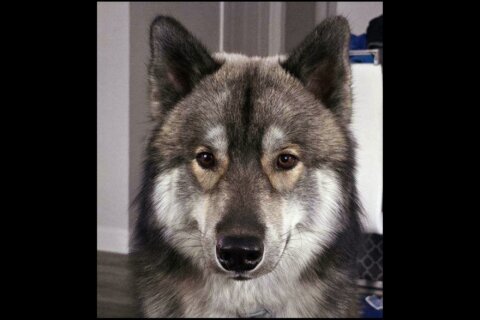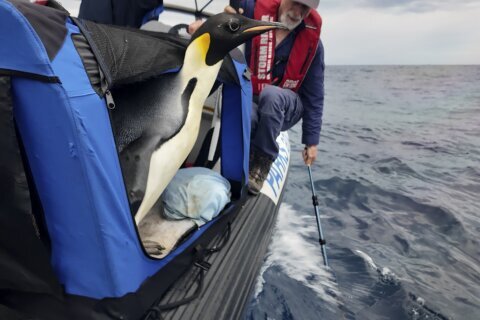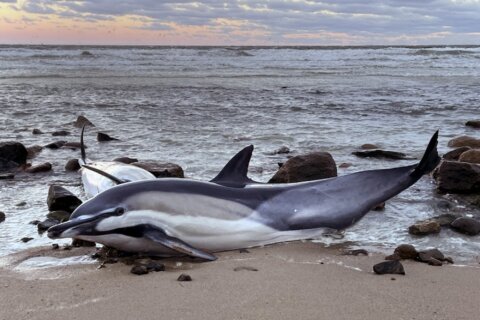YELLOWSTONE NATIONAL PARK, Wyo. (AP) — Standing at the edge of a bluff overlooking the Lamar River in Yellowstone National Park, TJ Ammond stared through binoculars at hundreds of buffalo dotting the verdant valley below.
Tan-colored calves frolicked near their mothers while hulking bulls wallowed in mud.
As his wife and young children clustered behind him, Ammond panned the vast herd and cried out: “I see a white one!”
“Or no — that’s a pronghorn,” he soon corrected. “It’s white and it’s small.”
Grizzly bears and wolves are usually the star attractions for wildlife watchers in Yellowstone but this spring, a tiny and exceedingly rare white buffalo calf has stolen the show.
White buffalo — also known as bison — are held sacred by many Native Americans who greeted news of the birth of one in Yellowstone as an auspicious sign.
It all began when Kalispell, Montana, photographer Erin Braaten snapped several images of the tiny, ungainly creature nuzzling with its mother on June 4, soon after its birth near the banks of the Lamar River. Braaten and her family had been driving through the park when she spotted “something really white” and got a closer look through her telephoto lens.
They turned around and pulled over to watch and shoot photos of the calf with its mother for over half an hour.
Despite throngs of visitors with scopes and photographers with telephoto lenses in the Lamar Valley, a prime spot for wildlife viewing in Yellowstone, few others saw the calf and no sightings have been reported since. Even Braaten and her family did not see the calf again despite going back to look over the next two days, she said.
As in legend, the calf remains mysterious in life.
Some speculate it was a short one. Bison calves often don’t survive when their herds decide to plunge across waters like the Lamar, which has been flowing high and muddy with mountain snowmelt.
Yet even if it has died, the event is no less significant to Native Americans, said Chief Arvol Looking Horse, spiritual leader of the Lakota, Dakota and the Nakota Oyate in South Dakota, and the 19th keeper of the sacred White Buffalo Calf Woman Pipe and Bundle.
“The thing is, we all know that it was born and it’s like a miracle to us,” Looking Horse said.
The creature’s birth fulfills a Lakota prophecy that portends better times, according to members of the American Indian tribe who caution that it’s also a signal that more must be done to protect the earth and its animals. They plan a ceremony in the coming weeks to commemorate the event.
Word of the white buffalo has meanwhile spread far and wide. Ammond had heard about the white calf on The Weather Channel and was keen to see it on his family’s trip to Yellowstone from Ohio.
Usually, white bison are born in ranch herds due to interbreeding with cattle. They are rare but not unheard of, with births making local headlines every so often.
Two genetic variations, leucism and albinism, account for an unusually light-colored animal. Experts doubt the Yellowstone calf is an albino.
In any event, a wild white buffalo is exquisitely rare — maybe even unheard of in Yellowstone, one of the last sanctuaries for free-roaming American bison. The animals once numbered in the tens of millions before commercial hunting drove them to near extinction. Yellowstone’s herd numbers about 5,000.
For Yellowstone’s dedicated wildlife watchers, a good look or photo of a wolf, grizzly — or especially an elusive wolverine or lynx — makes for a good day in the field. A glimpse of the white bison calf would be the privilege of a lifetime.
Employees at several of the businesses that offer guided tours, hikes and horseback rides in Yellowstone said they had not seen the white bison calf. At least one was skeptical the sighting was authentic but a cellphone video provided by Braaten’s son, Zayne Braaten, showing the calf in a wide scene looking very much like the Lamar Valley left little room for doubt the calf is — or was — the real deal.
Amateur photographer Sabrina Midkiff, from Houston, said getting pictures of buffalo calves was the main purpose of her trip to the park this summer. She’d taken thousands of photos so far and wondered if the white calf was hidden somewhere in the crowd in one of her images.
Seeing it would be thrilling, Midkiff said, but she’d heard talk that it may have died — by drowning, getting eaten by wolves or coyotes, or simply being too weak to survive.
“There are a lot of things that could happen out here in the wild,” she said.
Near the site where Braaten said she took her photos, New Mexico native Bob Worthington stood outside his truck Thursday and scoped a distant hillside. He said he’d been visiting Yellowstone for 26 years with a singular focus: Seeing grizzly bears.
Worthington gruffly dismissed a query about the valley’s bison herds. But when the white calf was mentioned, he lit up with a grin.
“I’d love to get to see the little rascal,” he said.
___
TJ Ammond’s first name has been corrected.
___
Gruver reported from Cheyenne, Wyoming, and Hanson from Helena, Montana.
Copyright © 2024 The Associated Press. All rights reserved. This material may not be published, broadcast, written or redistributed.







